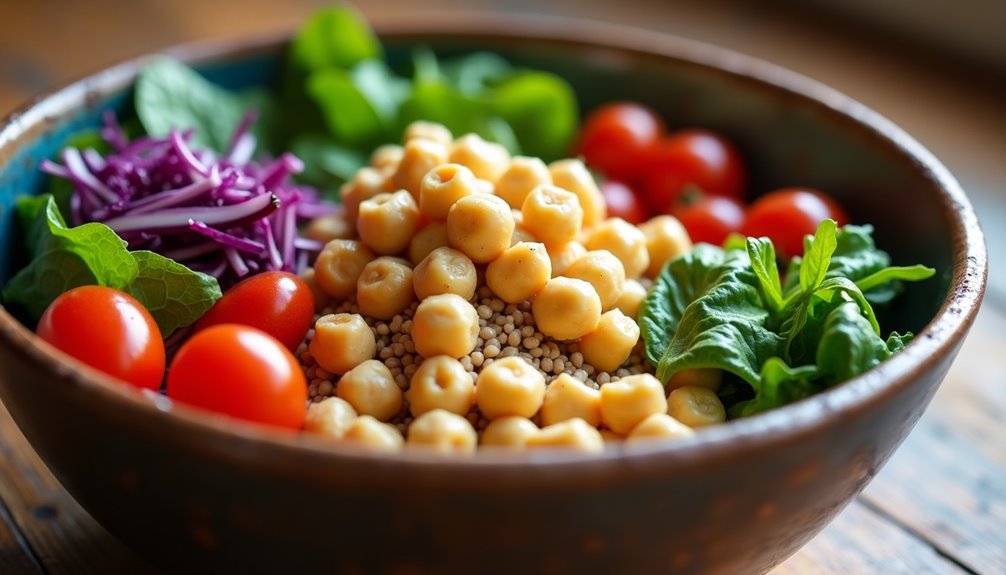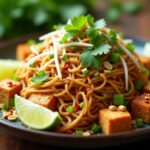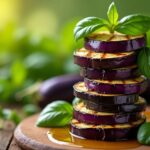A Quinoa and Chickpea Buddha Bowl is your go-to for a nutritious, customizable meal. It's loaded with plant-based protein from quinoa and chickpeas, both of which offer essential nutrients and fiber. Start by cooking quinoa with a 2:1 water ratio for a fluffy texture. Chickpeas can be soaked or used canned for convenience, and roasting them adds crunch. Layer these with colorful veggies like sweet potatoes and bell peppers, topped with a tahini dressing or vinaigrette for flavor. This bowl not only satisfies hunger but also nourishes your body. Explore more tips to make this meal unique and exciting!
Key Takeaways
- Combine cooked quinoa and chickpeas as the base for a nutritious Buddha bowl rich in plant-based protein.
- Add roasted vegetables like sweet potatoes and bell peppers for flavor and antioxidant benefits.
- Incorporate leafy greens such as spinach or kale for added nutrients and color.
- Drizzle with a tahini-based dressing or vinaigrette to enhance taste and creaminess.
- Customize your bowl with fresh herbs, sesame seeds, or additional toppings for extra flavor and texture.
Ingredients Overview
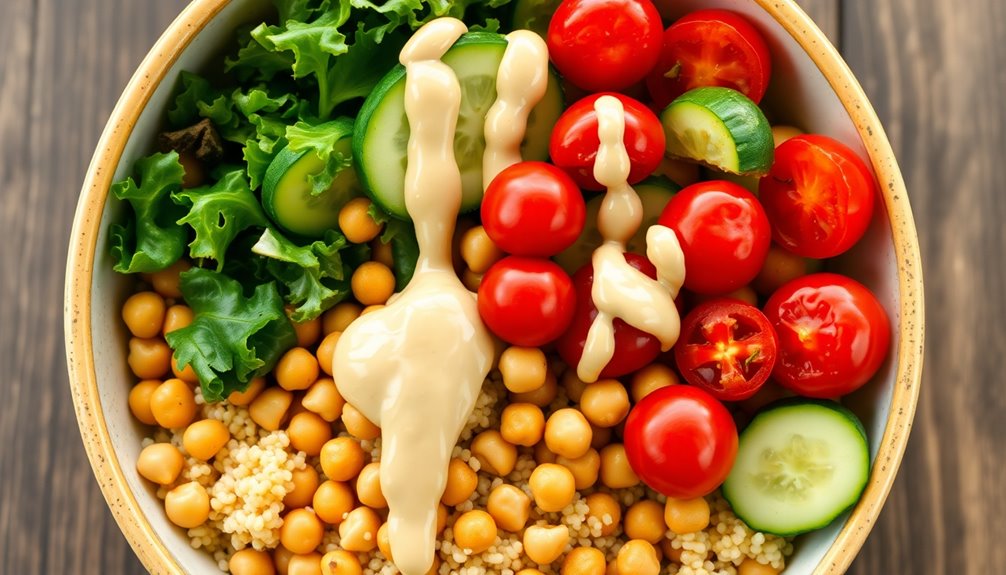
In preparing your Quinoa and Chickpea Buddha Bowl, you'll want to gather a variety of fresh and nutritious ingredients that not only contribute to the dish's vibrant flavors but also provide a balanced meal. Start with quinoa and chickpeas as your base, both offering impressive nutritional value. Quinoa provides complete protein, while chickpeas add fiber and essential vitamins, supporting digestive health.
For flavor profiles, consider including roasted vegetables like sweet potatoes, bell peppers, or zucchini. Roasting enhances their natural sweetness and adds depth to your bowl.
You might also want to toss in some leafy greens, such as spinach or kale, for a fresh crunch and additional nutrients.
When it comes to cooking methods, quinoa can be easily cooked on the stovetop or in a rice cooker, making it a versatile choice. Chickpeas can be used canned for convenience or cooked from dry for a more robust flavor.
Be mindful of dietary restrictions. This Buddha bowl is naturally gluten-free and can cater to various dietary preferences, such as vegan or vegetarian. You can customize the ingredients to accommodate those with specific needs, ensuring everyone can enjoy a nourishing meal together.
Exploring different toppings, like avocado, seeds, or a tahini dressing, can elevate your dish further while enriching the flavor profiles. Additionally, incorporating a variety of ingredients can help you take advantage of the significant health benefits of a plant-based diet. By thoughtfully selecting your ingredients, you create a delightful and satisfying Buddha bowl that welcomes everyone to the table.
Health Benefits
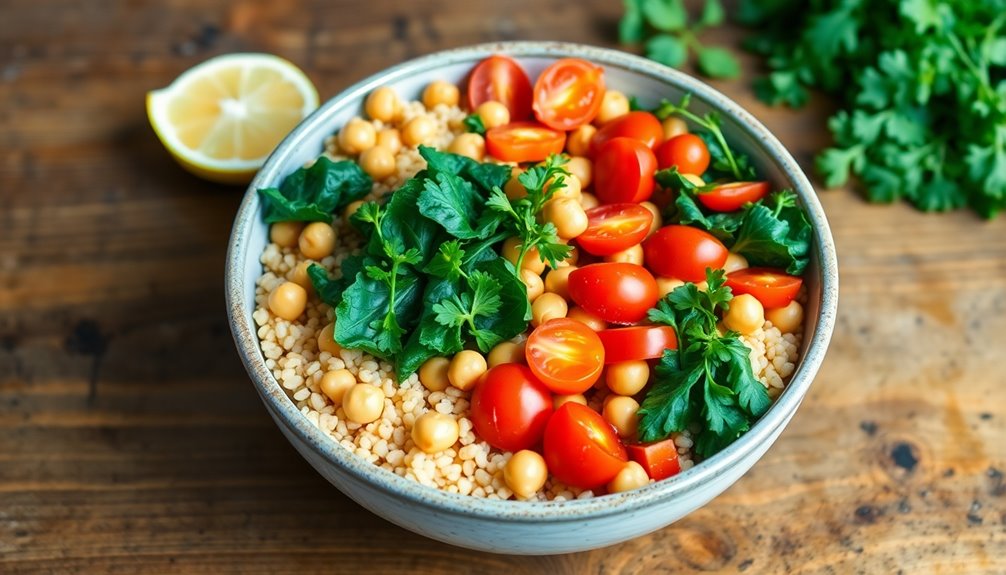
A Quinoa and Chickpea Buddha Bowl offers a wealth of health benefits that can enhance your overall well-being. Packed with nutritional advantages, this dish combines two powerhouse ingredients: quinoa and chickpeas. Both are excellent sources of plant-based protein, making them ideal for anyone looking to maintain or build muscle without relying on animal products.
Quinoa is a complete protein, meaning it contains all nine essential amino acids your body needs. Chickpeas add additional protein while also bringing a healthy dose of fiber content to the mix. This high fiber content aids digestion, helps maintain steady blood sugar levels, and keeps you feeling full longer, which can be beneficial if you're managing your weight.
Moreover, this Buddha bowl is rich in antioxidants, which play an essential role in protecting your body from oxidative stress. The colorful veggies you can add, like bell peppers and spinach, further enhance these antioxidant benefits, supporting your immune system and overall health. Additionally, incorporating whole food sources of protein into your meals can help you avoid the potential risks associated with processed protein powders.
Cooking Quinoa
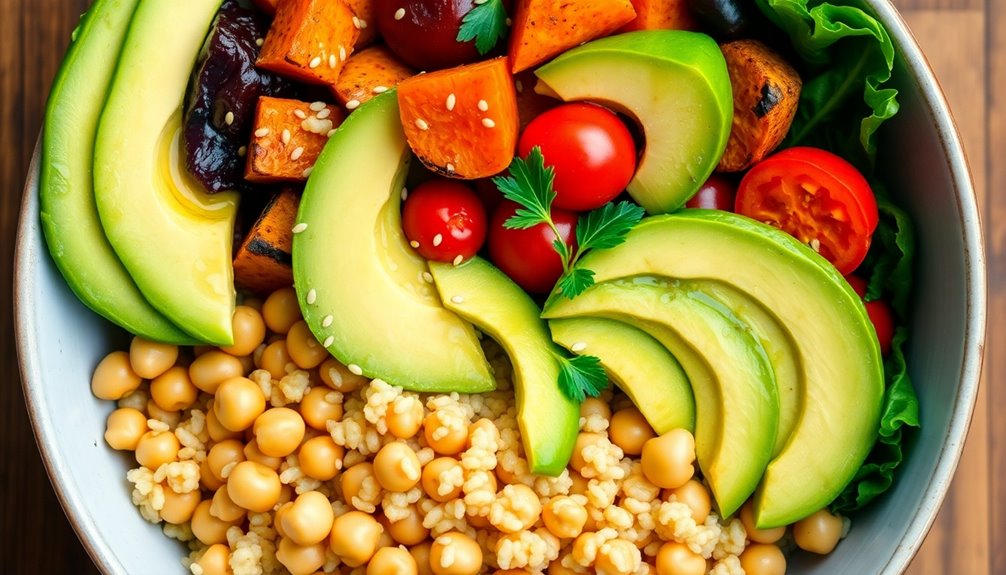
Cooking quinoa is straightforward, making it a convenient addition to your meals. To get started, rinse the quinoa under cold water to remove its natural coating, called saponin, which can impart a bitter taste. Use a 2:1 water-to-quinoa ratio for perfect results. Bring the water to a boil, add the quinoa, then reduce the heat and cover. In about 15 minutes, you'll find the grains tender and fluffy, with a delightful quinoa texture that's both nutty and slightly crunchy. Incorporating nutrient-rich ingredients can further enhance the dish's health benefits.
To enhance your experience, consider various flavor pairings that complement quinoa beautifully. You might enjoy mixing it with roasted vegetables, fresh herbs, or a zesty dressing to create a balanced dish.
Here's a simple table to guide your flavor explorations:
| Flavor Pairing | Description | Ideal Complement |
|---|---|---|
| Roasted Veggies | Brings sweetness and depth | Chickpeas |
| Fresh Herbs | Adds brightness and freshness | Lemon Dressing |
| Nuts and Seeds | Offers crunch and healthy fats | Avocado |
Experimenting with these combinations can elevate your meals and help you feel more connected to your cooking. Quinoa's versatility means it easily adapts to your favorite ingredients, allowing you to create a dish that truly reflects your taste. So, immerse yourself and enjoy the journey of cooking quinoa—it's a satisfying way to nourish both body and soul!
Preparing Chickpeas
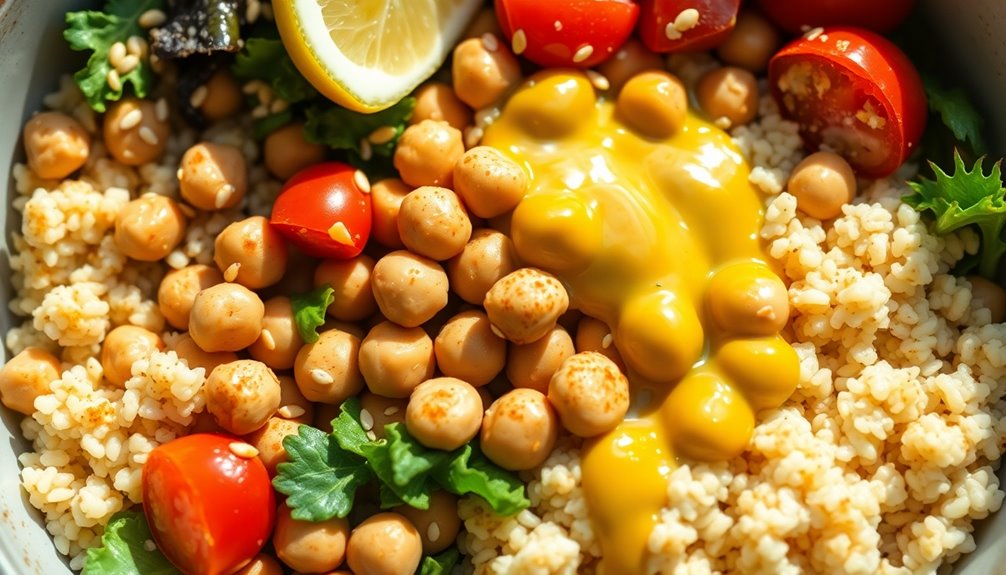
Preparing chickpeas can be a game-changer for your Buddha bowl. Not only do they add a hearty texture and protein boost, but they also offer endless possibilities for flavor. Whether you're using canned or dried chickpeas, the key is in the preparation.
If you're using dried chickpeas, soak them overnight and then cook them until tender. This method enhances their natural flavor and texture. However, if you're pressed for time, canned chickpeas are a convenient option—just rinse and drain them before use.
One of the most popular ways to enjoy chickpeas is by roasting them. Roasting chickpeas elevates their flavor and adds a satisfying crunch. Preheat your oven to 400°F (200°C), toss the chickpeas with a little olive oil, and spread them in a single layer on a baking sheet. Roast for about 20-30 minutes, shaking the pan halfway through to make sure of even cooking.
Now, let's talk about seasoning options. You can go classic by sprinkling them with salt and pepper, or get creative with spices like smoked paprika, garlic powder, or even a pinch of cayenne for heat. If you're feeling adventurous, try a blend of cumin and coriander for an earthy flavor.
No matter how you choose to prepare them, roasted and seasoned chickpeas can transform your Buddha bowl into a nourishing, delicious meal that everyone can enjoy. So, give them a try and watch your bowl come to life!
Selecting Vegetables

When selecting vegetables for your Buddha bowl, it's important to mix and match for both flavor and nutrition. Start by considering a variety of colors and textures; this not only makes your meal visually appealing but also guarantees a range of nutrients. Dark leafy greens like spinach or kale provide iron and vitamins A and C, while vibrant bell peppers add a sweet crunch and a dose of antioxidants.
When it comes to veggie pairing, think about how different vegetables complement each other. For instance, roasted sweet potatoes offer a creamy sweetness that balances the sharpness of radishes or arugula.
You might also enjoy pairing crunchy cucumbers with creamy avocados, creating a delightful contrast in textures.
Don't forget about cooking methods. Steaming, roasting, or grilling can enhance flavors and make textures more appealing. Seasoning options are essential here; spices like paprika or cumin can lift the taste of your veggies without overwhelming them.
A sprinkle of sea salt and a squeeze of lemon juice can also bring out natural flavors.
Dressing Options
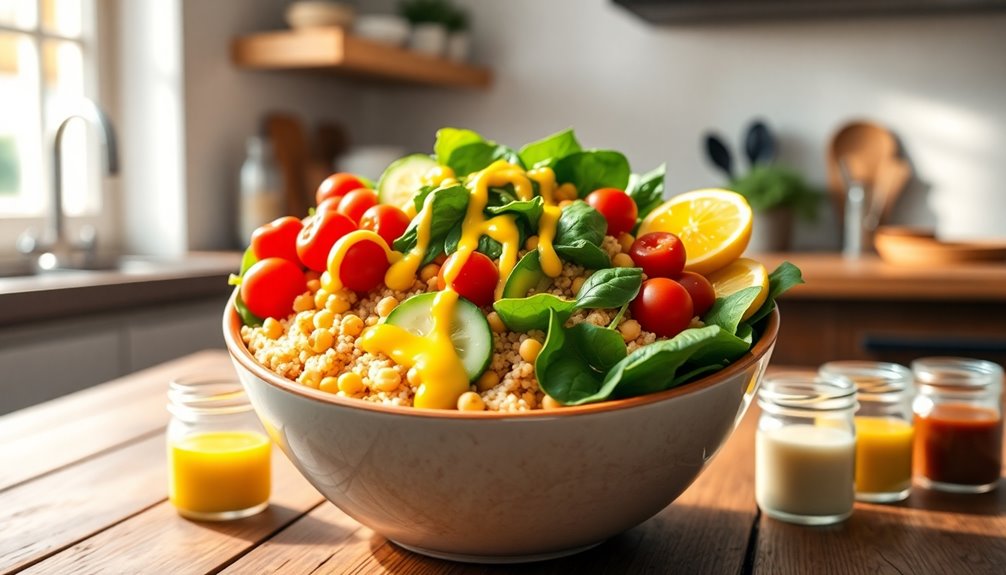
A well-chosen dressing can elevate your Buddha bowl, adding both flavor and nutritional benefits. When you think about dressing options, consider how they enhance the overall experience of your meal. A great dressing not only ties together various ingredients but also introduces exciting flavor combinations that can take your bowl to the next level.
For a creamy touch, try a tahini-based dressing mixed with lemon juice, garlic, and a hint of maple syrup. This combination provides a rich, nutty flavor that complements the earthiness of chickpeas.
If you prefer something lighter, a simple vinaigrette made with olive oil, balsamic vinegar, and Dijon mustard can add a zesty kick while balancing the dish's textures. The acidity from the vinegar cuts through the creaminess of avocado or roasted vegetables, creating satisfying texture contrasts.
Don't shy away from experimenting with spices and herbs either. A cilantro-lime dressing can bring fresh brightness, while a smoky chipotle sauce adds depth. These options not only cater to diverse palates but also promote a sense of belonging through shared culinary experiences.
As you explore these dressing options, remember that the right choice can transform your quinoa and chickpea Buddha bowl into a delightful meal. By combining flavors and textures thoughtfully, you'll create a dish that's not only nourishing but also inviting for everyone at the table.
Assembly Instructions
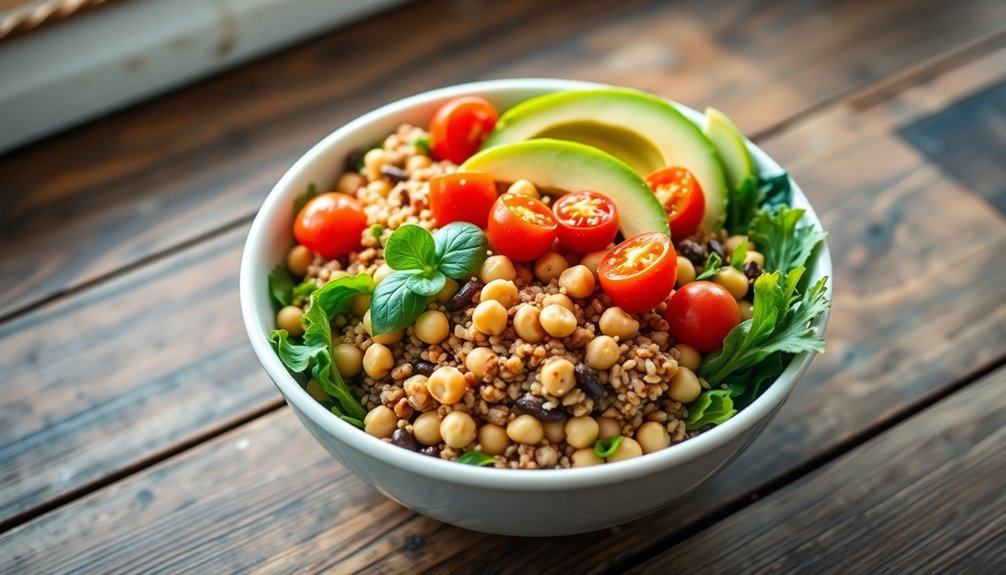
To create a harmonious quinoa and chickpea Buddha bowl, start by layering your ingredients in a deep bowl or plate. Begin with a generous base of cooked quinoa; this not only provides a nutty flavor but also serves as a nutrient-rich foundation.
Next, add a serving of chickpeas for protein and fiber, promoting satiety and a balanced meal.
Once your base is ready, it's time to incorporate vibrant vegetables. Consider using fresh spinach, cherry tomatoes, and sliced cucumbers for added crunch and color. These choices not only enhance the bowl presentation but also provide essential vitamins and minerals.
You could also add roasted sweet potatoes or steamed broccoli for a warm, comforting touch.
After assembling your main ingredients, think about your garnishes. Fresh herbs, like cilantro or parsley, can elevate the flavors significantly. You might also sprinkle some sesame seeds or pumpkin seeds for a delightful crunch. If you're feeling adventurous, a dollop of hummus or a drizzle of tahini can deepen the flavor profile and add creaminess.
Meal Prep Tips
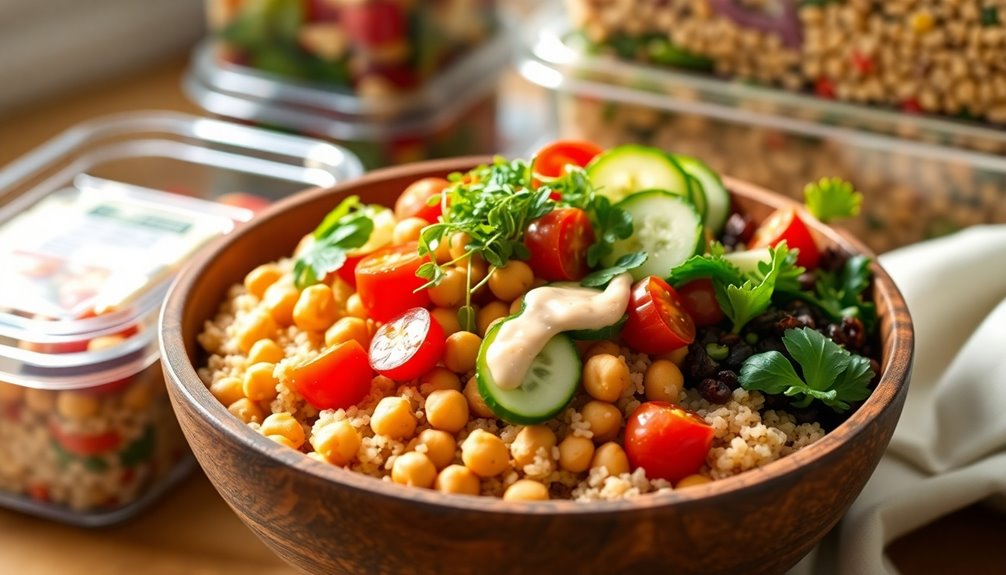
While meal prepping for your quinoa and chickpea Buddha bowl, focus on efficiency and freshness to guarantee your ingredients maintain their flavor and nutritional value throughout the week. Start by organizing your kitchen. A well-organized space allows you to quickly access all ingredients and tools, saving you precious time. Label containers for easy identification, and group similar items together to streamline your cooking process.
Next, plan your meals ahead. By dedicating a specific day for meal prep, you can better manage your time throughout the week. Consider cooking a large batch of quinoa and chickpeas together, as they can serve as the base for multiple meals. Store them in airtight containers to keep them fresh longer.
When it comes to chopping vegetables, batch prep is your friend. Cut up an assortment of colorful veggies at once and store them in separate containers. This not only saves time but also helps you create a visually appealing bowl when you're ready to eat.
Don't forget to prepare your dressings in advance! This step enhances your flavor profile and makes assembling your bowls a breeze. Finally, keep an eye on expiration dates for your fresh ingredients, rotating them as needed to minimize waste. By mastering kitchen organization and honing your time management skills, you'll not only make meal prep enjoyable but also foster a sense of community as you share your delicious Buddha bowls with friends and family.
Variations and Substitutes
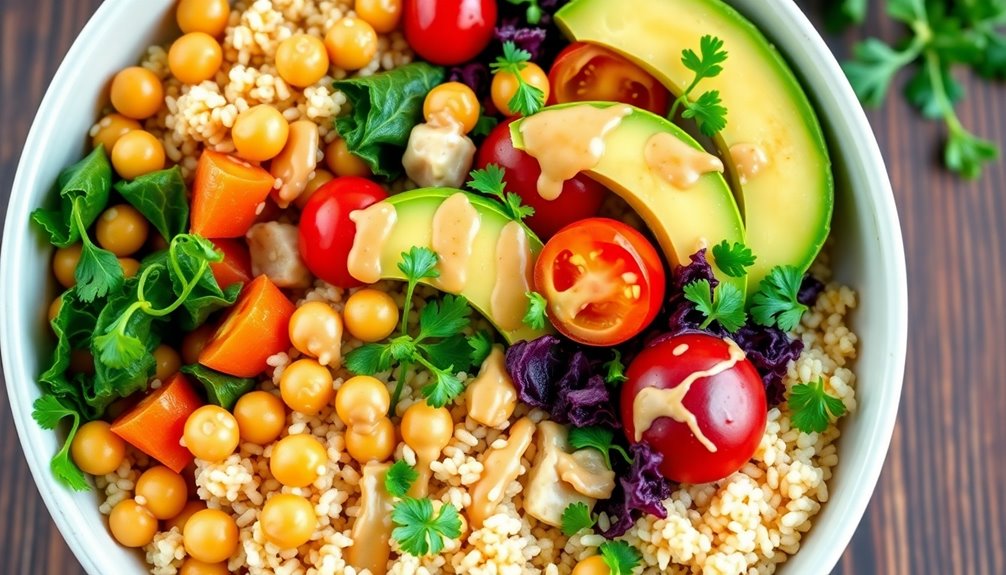
Creativity in the kitchen opens doors to endless possibilities when it comes to variations and substitutes for your quinoa and chickpea Buddha bowl. You don't have to stick to the same ingredients every time; switching things up can enhance both the nutrition and flavor profiles of your meal.
If you're looking for alternative protein sources, consider adding lentils, edamame, or even grilled tofu. These options not only pack a protein punch but also bring their unique textures and flavors. For a heartier bowl, you might incorporate tempeh, which offers a nutty taste and additional crunch.
When it comes to vegetables, the sky's the limit. Roasted sweet potatoes, sautéed kale, or fresh spinach can all provide different tastes and nutrients. You could also explore seasonal veggies for a fresh twist, like asparagus in spring or butternut squash in fall.
Don't forget about grains! While quinoa is a staple, switching to farro, brown rice, or even cauliflower rice can add variety to your base. Each grain has its own flavor profile, so feel free to experiment.
For dressings, you can mix up the flavors by using tahini, a lemon-tahini sauce, or even a spicy peanut sauce. Each choice can transform your bowl into something uniquely delightful. By playing with these variations and substitutes, you'll keep your Buddha bowl exciting and nutritious, making every meal feel special.
Serving Suggestions
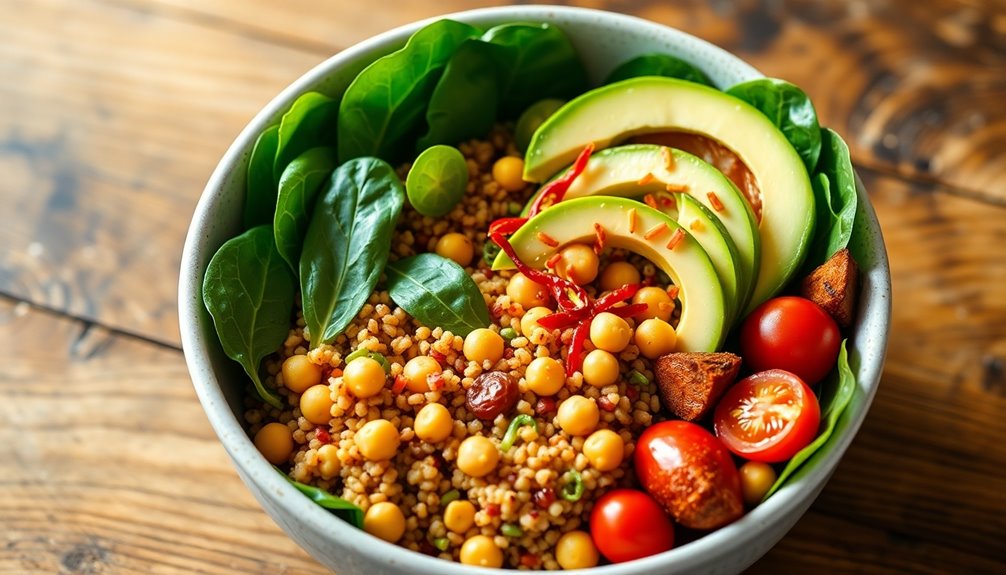
When it comes to serving your quinoa and chickpea Buddha bowl, presentation can elevate the dining experience. A well-arranged bowl not only appeals to the eye but also enhances the flavors through thoughtful ingredient pairings. To create a visually stunning meal, consider these tips for bowl presentation:
- Layering Colors: Use a variety of colorful vegetables like bright bell peppers, deep green spinach, and vibrant purple cabbage. This not only looks appealing but also provides a range of nutrients.
- Textural Variety: Combine creamy avocado slices with crunchy seeds or nuts. The contrast in textures adds excitement to each bite.
- Garnishing with Herbs: Fresh herbs like cilantro or parsley can brighten the dish and add a burst of freshness.
- Creative Drizzling: A drizzle of tahini, yogurt, or a homemade vinaigrette can bring all the flavors together while adding a touch of elegance.
- Personal Touch: Don't hesitate to include ingredients that resonate with you or your loved ones, like roasted sweet potatoes or pickled red onions.
These serving suggestions not only enhance the aesthetics but also foster a sense of connection with the food. When you put thought into your bowl presentation and ingredient pairings, you create a warm atmosphere that invites family and friends to gather and enjoy. Remember, a beautiful Buddha bowl is more than just a meal; it's an experience that nurtures both body and soul.
Frequently Asked Questions
Can I Make a Buddha Bowl in Advance?
Yes, you can definitely make a Buddha bowl in advance! For effective meal prep, prepare your ingredients separately and store them in airtight containers. Keep your grains, proteins, and veggies separate to maintain freshness.
When you're ready to eat, just combine them. For storage tips, try using glass containers to avoid any plastic taste. This way, you'll enjoy a nutritious meal throughout the week while saving time and staying organized in the kitchen!
What Are Some Good Toppings for Extra Flavor?
To amp up the flavor in your bowl, consider adding some flavorful sauces like tahini, sriracha, or a zesty vinaigrette. These can really elevate your dish.
Don't forget about crunchy toppings; think roasted nuts, seeds, or crispy chickpeas. They add texture and a satisfying crunch that complements your bowl.
Experiment with different combinations to find what you love, and you'll create a meal that's not just nourishing but also bursting with taste.
Is It Safe to Eat Leftover Quinoa?
Yes, it's safe to eat leftover quinoa if you store it properly. Make certain you refrigerate it within two hours of cooking and keep it in an airtight container. When reheating, you can use the microwave or stovetop, adding a splash of water to keep it moist. Just make certain it's heated to at least 165°F to eliminate any potential bacteria. Following these storage tips will help you enjoy your leftovers safely!
How Long Does a Buddha Bowl Last in the Fridge?
A Buddha bowl's freshness can dwindle like a wilting flower, so knowing its shelf life is key. Typically, a well-stored Buddha bowl lasts about 3 to 5 days in the fridge. To maximize freshness, use airtight containers and keep it cool.
Can I Freeze a Buddha Bowl for Later Use?
Yes, you can freeze a Buddha bowl for later use! It's a great meal prep strategy that saves time. To guarantee the best quality, use airtight containers and separate ingredients that don't freeze well, like avocados or dressings.
When you're ready to eat, thaw it in the fridge overnight and reheat gently. Following these freezing tips, you'll enjoy your delicious meal whenever you want, making it a convenient choice for busy days.
Conclusion
Embracing a quinoa and chickpea Buddha bowl into your meals is like inviting a burst of color and nutrition onto your plate. With a wealth of health benefits and endless customization options, you can easily adapt it to suit your tastes and dietary needs. So, whether you're prepping for the week or looking for a quick lunch, this bowl is a nourishing choice that fuels both body and soul. Immerse yourself and enjoy the vibrant flavors!

